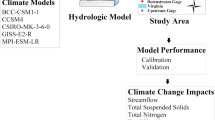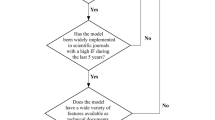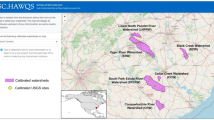Abstract
Various computer models, ranging from simple to complex, have been developed to simulate hydrology and water quality from field to watershed scales. However, many users are uncertain about which model to choose when estimating water quantity and quality conditions in a watershed. This study compared hydrologic/water quality models including Spreadsheet Tool for the Estimation of Pollutant Load (STEPL)-Purdue, Soil and Water Assessment Tool (SWAT), High Impact Targeting (HIT), Long-Term Hydrologic Impact Assessment (L-THIA), Pollutant Load (PLOAD), Spatially and Temporally Distributed Model for Phosphorus Management (STEM-P), Region 5, and ensemble modeling (using STEPL-Purdue, SWAT, L-THIA, PLOAD, and STEM-P). Model capabilities, inputs, and underlying methods to estimate streamflow, surface runoff, baseflow, nutrients, and sediment were examined. Uncalibrated, calibrated, and validated outputs of these models and uncalibrated ensemble modeling in estimating water quantity and quality for a 41.5 km2 agricultural watershed in Northeastern Indiana were explored, and suggestions were provided on the selection and use of models. Models need to be selected carefully based on the simulation objectives, data availability, model characteristics, time constraints, and project budgets.

Similar content being viewed by others
References
Abbaspour K, Vejdani M, Haghighat S, Oxley L, Kulasiri D (2007) SWAT-CUP calibration and uncertainty programs for SWAT. Modsim 2007: International Congress on Modelling and Simulation 1603-1609
Ahiablame L, Engel BA, Chaubey I (2012) Representation and evaluation of low impact development practices with L-THIA-LID: an example for site planning. Environ Pollut 1(2)
Arnold JG, Allen PM (1999) Automated methods for estimating baseflow and ground water recharge from streamflow records1. J Am Water Resour As 35(2):411–424
Azamathulla HM (2012) Linear programming for irrigation scheduling-a case study (book chapter). Linear programming: new frontiers in theory and applications 174–192
Azmi M, Sarmadi F (2015) Dynamic modelling of water resources sustainable development using a mathematical approach. KSCE J Civ Eng 19(6):1675
Bhaduri B, Minner M, Tatalovich S, Harbor J (2001) Long-term hydrologic impact of urbanization: a tale of two models. J Water Res Pl-ASCE 127(1):13–19
Chen J, Theller L, Gitau MW, Engel BA, Harbor JM (2017) Urbanization impacts on surface runoff of the contiguous United States. J Environ Manag 187:470–481
Coffey ME, Workman SR, Taraba JL, Fogle AW (2004) Statistical procedures for evaluating daily and monthly hydrologic model predictions. T ASAE 47(1):59
Diodato N, Guerriero L, Fiorillo F, Esposito L, Revellino P, Grelle G, Guadagno FM (2014) Predicting monthly spring discharges using a simple statistical model. Water Resour Manag 28(4):969–978
Duan Q, Gupta HV, Sorooshian S, Rousseau AN, Turcotte R (2003) Calibration of watershed models. Am Geophys Union 6:1–345
Duan Q, Ajami NK, Gao X, Sorooshian S (2007) Multi-model ensemble hydrologic prediction using Bayesian model averaging. Adv Water Resour 30(5):1371–1386
Engel BA, Choi JY, Harbor J, Pandey S (2003) Web-based DSS for hydrologic impact evaluation of small watershed land use changes. Comput Electron Agr 39:241–249
Foster GR, McCool DK, Renard KG, Moldenhauer WC (1981) Conversion of the universal soil loss equation to SI metric units. J Soil Water Conserv 36(6):355–359
Fraser R (1999) SEDMOD: a GIS-based delivery model for diffuse source pollutants (doctoral dissertation). Yale University
Ghavidelfar S, Alvankar SR, Razmkhah A (2011) Comparison of the lumped and quasi-distributed Clark runoff models in simulating flood hydrographs on a semi-arid watershed. Water Resour Manag 25(6):1775–1790
Gitau MW, Chen J, Ma Z (2016) Water quality indices as tools for decision making and management. Water Resour Manag 30(8):2591–2610
Harbor J (1994) A practical method for estimating the impact of land use change on surface runoff, groundwater recharge and wetland hydrology. J Am Plan Assoc 60:91–104
Jones PG, Thornton PK (2013) Generating downscaled weather data from a suite of climate models for agricultural modelling applications. Agric Syst 114:1–5
Laouacheria F, Mansouri R (2015) Comparison of WBNM and HEC-HMS for runoff hydrograph prediction in a small urban catchment. Water Resour Manag 29(8):2485–2501
Li S, Zhang L, Gitau M, Engel BA, Liu HB, Flanagan D (2017) Development of a spatially and temporally distributed hydrological and phosphorus model to facilitate non-point source pollution control. Department of Agricultural and Biological Engineering Report. Purdue University, West Lafayette, IN
Liu Y, Ahiablame LM, Bralts VF, Engel BA (2015a) Enhancing a rainfall-runoff model to assess the impacts of BMPs and LID practices on storm runoff. J Environ Manag 147:12–23
Liu Y, Bralts VF, Engel BA (2015b) Evaluating the effectiveness of management practices on hydrology and water quality at watershed scale with a rainfall-runoff model. Sci Total Environ 511:298–308
Liu Y, Chaubey I, Bowling LC, Bralts VF, Engel BA (2016a) Sensitivity and uncertainty analysis of the L-THIA-LID 2.1 model. Water Resour Manag 30(13):4927–4949
Liu Y, Cibin R, Bralts VF, Chaubey I, Bowling LC, Engel BA (2016b) Optimal selection and placement of BMPs and LID practices with a rainfall-runoff model. Environ Modell Softw 80:281–296
Liu Y, Theller LO, Pijanowski BC, Engel BA (2016c) Optimal selection and placement of green infrastructure to reduce impacts of land use change and climate change on hydrology and water quality: An application to the Trail Creek Watershed, Indiana. Sci Total Environ 553:149–163
MDEQ (Michigan Department of Environmental Quality) (1999) Pollutants controlled calculation and documentation for section 319 watersheds training manual. Lansing
Mishra SK, Singh VP (2004) Long-term hydrological simulation based on the soil conservation Service curve number. Hydrol Process 18(7):1291–1313
Moriasi DN, Arnold JG, Van Liew MW, Bingner RL, Harmel RD, Veith TL (2007) Model evaluation guidelines for systematic quantification of accuracy in watershed simulations. T ASABE 50(3):885–900
Neitsch SL, Arnold JG, Kiniry JR, Williams JR (2011) Soil and water assessment tool theoretical documentation version 2009. Texas Water Resources Institute, College Station
NRC (National Research Council) (2001) Assessing the TMDL approach to water quality management. National Research Council, Washington, D.C.
Osei-Twumasi A, Falconer RA, Bockelmann-Evans BN (2015) Experimental studies on water and solute transport processes in a hydraulic model of the Severn estuary, UK. Water Resour Manag 29(6):1731–1748
Ouyang D, Bartholic J, Selegean J (2005) Assessing sediment loading from agricultural croplands in the Great Lakes Basin. J Am Sci 1(2):14–21
Ouyang Y, Xu D, Leininger TD, Zhang N (2016) A system dynamic model to estimate hydrological processes and water use in a eucalypt plantation. Ecol Eng 86:290–299
Park YS (2014) Development and enhancement of web-based tools to develop Total maximum daily load (Doctoral dissertation, PURDUE UNIVERSITY)
PLOAD (2001) PLOAD version 3.0: an ArcView GIS tool to calculate nonpoint sources of pollution in watershed and stormwater projects, User’s manual. U.S. Environmental Protection Agency, Washington, D.C.
Renard K, Foster G, Weesies G, McCool D, Yoder D (1996) Predicting soil erosion by water: a guide to conservation planning with the revised universal soil loss equation (RUSLE). USDA, agriculture handbook number 703
Runkel RR, Crawford CG, Cohn TA (2004) Load Estimator (LOADEST): a Fortran program for estimating constituent loads in streams and rivers. Techniques and methods book 4, chapter A5. US Geological Survey, Reston
Schueler T (1987) Controlling urban runoff: a practical manual for planning and designing urban BMPs. Metropolitan Washington Council of Governments, Washington, D.C.
Shi P, Chen C, Srinivasan R, Zhang X, Cai T, Fang X, Qu S, Chen X, Li Q (2011) Evaluating the SWAT model for hydrological modeling in the Xixian watershed and a comparison with the XAJ model. Water Resour Manag 25(10):2595–2612
Spruill C, Workman S, Taraba J (2000) Simulation of daily and monthly stream discharge from small watersheds using the SWAT model. T ASAE 43(6):1431–1439
Tetra Tech, Inc (2011) User’s guide spreadsheet tool for the estimation of pollutant load (STEPL) version 4.1. Tetra Tech, Inc, Fairfax
Thiessen AH (1911) Precipitation averages for large areas. Mon Weather Rev 39(7):1082–1089
Turner BL, Menendez HM, Gates R, Tedeschi LO, Atzori AS (2016) System dynamics modeling for agricultural and natural resource management issues: review of some past cases and forecasting future roles. Resour 5(4):40
USEPA (United States Environmental Protection Agency) (2001) PLOAD version 3.0, an ArcView GIS tool to calculate nonpoint sources of pollution in watershed and Stormwater projects, User’s Manual
Viney NR, Bormann H, Breuer L, Bronstert A, Croke BFW, Frede H, Gräff T, Hubrechts L, Huisman JA, Jakeman AJ, Kite GW (2009) Assessing the impact of land use change on hydrology by ensemble modelling (LUCHEM) II: ensemble combinations and predictions. Adv Water Resour 32(2):147–158
Wang R, Bowling LC, Cherkauer KA, Cibin R, Her Y, Chaubey I (2017) Biophysical and hydrological effects of future climate change including trends in CO2, in the St. Joseph River watershed, Eastern Corn Belt. Agr Water Manage 180:280–296
Wang R, Kalin L, Kuang W, Tian H (2014) Individual and combined effects of land use/cover and climate change on Wolf Bay watershed streamflow in southern Alabama. Hydrol Process 28(22):5530–5546
White KL, Chaubey I (2005) Sensitivity analysis, calibration, and validations for a multisite and multivariable swat model. J Am Water Resour Assoc 41:1077–1089
Wright TJ, Liu Y, Carroll NJ, Ahiablame LM, Engel BA (2016) Retrofitting LID practices into existing neighborhoods: is it worth it? Environ Manag 57(4):856–867
Zahiri A, Azamathulla HM, Ghorbani K (2014) Prediction of local scour depth downstream of bed sills using soft computing models. In computational intelligence techniques in earth and environmental Sciences. Springer, Netherlands, pp 197–208
Acknowledgements
Support for this work was provided by the Illinois-Indiana Sea Grant College Program under Award Number 2014-02342-06.
Author information
Authors and Affiliations
Corresponding author
Rights and permissions
About this article
Cite this article
Liu, Y., Li, S., Wallace, C.W. et al. Comparison of Computer Models for Estimating Hydrology and Water Quality in an Agricultural Watershed. Water Resour Manage 31, 3641–3665 (2017). https://doi.org/10.1007/s11269-017-1691-9
Received:
Accepted:
Published:
Issue Date:
DOI: https://doi.org/10.1007/s11269-017-1691-9




